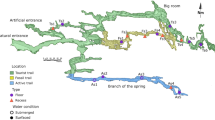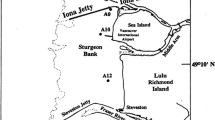Abstract
Ten sediment trap arrays were deployed over two years for periods of 3 to 40 days in three different sampling points along a 50 m long Mediterranean submarine cave. Mean total particulate matter flux decreased strongly from the semi-dark area (3.3 g m−2 d−1) to the dark area (0.8 and 0.6 g m−2 d−1). Carbon represented 3.3% to 3.5% and nitrogen 0.34% to 0.38% of settling dry matter. The decrease in organic input from the entrance to the terminal part of the cave results in increasingly oligotrophic conditions with distance from the cave entrance. Horizontal resource limitation can be connected with a strong zonal decrease in fauna richness. Biomass declines both in hard substrate and soft bottom communities. Despite major differences, some similarities are noticed between oligotrophic conditions that may occur in the dark cave and those in around 1000 m depth ecosystems. Dark oligotrophic submarine caves can be considered to be good scale models for the study of some aspects of general trophic pathways.
Similar content being viewed by others
References
Blomqvist, S. & L. Hakanson, 1981. A review on sediment traps in aquatic environments. Arch. Hydrobiol. 91: 101–132.
Blomqvist, S. & C. Kofoed, 1981. Sediment trapping a subaquatic in situ experiment. Limnol. Oceanogr. 26: 585–590.
Buscail, R., L. Guidi & F. de Bovée, 1987. Flux de matière organique, variations des paramètres biochimique et dynamique biologique dans le canyon Lacaze-Duthiers (golfe du Lion). Coll. int. Oceanol., Perpignan, Comm. int. Médit. (CIESM), Monaco: 75.
Butman, C. A., 1986. Sediment trap biases in turbulent flows: result from a laboratory flume study. J. mar. Res. 44: 645–693.
Byers, S. C., E. L. Mills & P. L. Stewart, 1978. A comparison of methods of determining organic carbon in marine sediments with sugestion for a standard method. Hydrobiologia 58: 43–47.
Cauwet, G., 1985. Dynamique de la matière organique dans les milieux marins et polyhalins: son role dans les processus géochimiques aux interfaces. Thèse Doct. ès Sci. Univ. Perpignan, 389 p.
Fichez, R., 1989. Phénomènes d'oligotrophie en milieu aphotique, étude des grottes sous-marines, comparaison avec les milieux profonds et bilans énergétiques. Thèse Doct. Univ. d'Aix-Marseille II, 251 p.
Fichez, R., 1990. Les pigments chlorophylliens: indices d'oligotrophie dans les grottes sous-marines. C. r. Acad. Sci. Paris (ser. III). 310: 155–161.
Gardner, W. D., 1980a. Sediment trap dynamics and calibration: a laboratory evaluation. J. mar. Res. 38: 17–39.
Gardner, W. D., 1980b. Field assessment of sediment traps. J. mar. Res. 38: 41–52.
Gili, J. M., T. Riera & M. Zabala, 1986. Physical and biological gradients in a submarine cave on the Western Mediterranean coast, (North-East Spain). Mar. Biol. 90: 291–297.
Hargrave, B. T. & N. M. Burns, 1979. Assessment of sediment trap collection efficiency. Limnol. Oceanogr. 24: 1124–1135.
Hargrave, B. T. & G. A. Phillips, 1986. Dynamics of the benthic foods web; St. Georges Bay, southern Gulf of St. Laurence. Mar. Ecol. Prog. Ser. 31: 277–294.
Harmelin, J. G., 1969. Bryozoaires des grottes sous-marines obscures de la région marseillaise, faunistique et écologie. Téthys 1: 793–806.
Harmelin, J. G., J. Vacelet & P. Vasseur, 1985. Les grottes sous-marines obscures: un milieu extréme et un remarquable biotope refuge. Téthys 11: 214–229.
Hinga, K. R., J. Mc N. Sieburth & G. R. Heath, 1979. The supply and use of organic material at the deep-sea floor. J. mar. Res. 37: 557–579.
Hirota, J. & J. P. Szyper, 1975. Separation of total carbon into inorganic and organic components. Limnol. Oceanogr. 20: 896–900.
Karl, D. M. & G. A. Knauer, 1984. Vertical distribution, transport and exchange of carbon in the northeast Pacific Ocean: evidence for multiple zones of biological activity. Deep-Sea Res. 31: 221–243.
Knauer, G. A., J. H. Martin & K. W. Bruland, 1979. Fluxes of particulate carbon, nitrogen and phosphorus in the upper water column of the northeast Pacific. Deep-Sea Res. 26: 97–108.
Kristensen, E. & F. O. Andersen, 1987. Determination of organic carbon in marine sediments: a comparison of two CHN-analyzer methods. J. exp. mar. Biol. Ecol. 109: 15–23.
Laborel, J. & J. Vacelet, 1958. Etude des peuplements d'une grotte sous-marine du golfe de Marseille. Bull. Inst. Océanogr., Monaco 55 (1120): 1–20.
Laborel, J. & J. Vacelet, 1959. Les grottes sous-marines obscures en Méditerranée. Cah. océanogr. 13: 73–107.
Lorenzen, C. J., F. R. Shuman, J. T. Bennett, 1981. In situ calibration of a sediment trap. Limnol. Oceanogr. 26: 580–585.
Lorenzen, C. J., N. A. Welschmeyer & A. E. Copping, 1983. Particulate organic carbon flux in the subartic Pacific. Deep-Sea Res. 30: 639–643.
Marinopoulos, J., 1989. Etude des peuplements infralittoraux de substrats rocheux de la région de Marseille et des facteurs abiotiques (lumière, hydrodynamique) les influençant. Thèse Doct. ès Sci., Univ. d'Aix-Marseille II, 646 p.
Monteiro-Marques, V., 1981. Peuplements des planchers envasés de trois grottes sous-marines de la région de Marseille. Etude préliminaire. Téthys 10: 89–96.
Noriki, S. & S. Tsunogai, 1986. Particulate fluxes and major components of settling particles from sediment trap experiments in the Pacific Ocean. Deep-Sea Res. 33: 903–917.
Pérès, J. M. & J. Picard, 1949. Notes sommaires sur le peuplement des grottes sous-marines de la région de Marseille. C. R. Soc. Biogéogr. 227: 42–45.
Smetacek, V., 1984. The supply of food to the benthos. In M. J. R. Fasham (ed.), Flows of energy and materials in marine ecosystems: theory and practice. Plenum Press, New-York: 517–547.
Spencer, D. W., P. G. Brewer, A. Fleer, S. Honjo, S. Krisnaswami & Y. Nozaki, 1978. Chemical fluxes from a sediment trap experiment in the deep Sargasso sea. J. mar. Res. 36: 493–523.
Tsunogai, S. & S. Noriki, 1987. Organic matter fluxes and the sites of oxygen consumption in deep water. Deep-Sea Res. 34: 755–767.
Author information
Authors and Affiliations
Rights and permissions
About this article
Cite this article
Fichez, R. Decrease in allochthonous organic inputs in dark submarine caves, connection with lowering in benthic community richness. Hydrobiologia 207, 61–69 (1990). https://doi.org/10.1007/BF00041441
Received:
Revised:
Accepted:
Issue Date:
DOI: https://doi.org/10.1007/BF00041441




